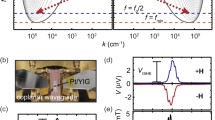Abstract
Magnetization dynamics is coupled with spin currents by exchanging the spin-angular momentum. This coupling allows to control magnetization by spin currents; spin injection into a ferromagnet induces magnetization precession. The inverse of this process, namely, spin current emission from precessing magnetization, is spin pumping, which offers a route for generating spin currents in a wide range of materials. This chapter describes experiments on the generation and detection of spin currents using the spin pumping and inverse spin-Hall effect. The inverse spin-Hall effect, conversion of spin currents into an electric voltage through spin-orbit interaction, induced by the spin pumping was first discovered in a metallic film. The spin pumping in this film is quantitatively consistent with a model calculation based on the Landau-Lifshitz-Gilbert equation. This dynamical spin injection, the spin pumping, offers an easy and versatile way for injecting spin currents into not only metals but also high-resistivity materials. In a metal/semiconductor junction, the spin pumping is demonstrated to be controlled electrically through the tuning of dynamical spin-exchange coupling at the interface. This spin-injection method works without applying a charge current, which makes it possible to generate spin currents from magnetic insulators; the spin pumping appears even in a metal/insulator junction due to finite spin-exchange interaction at the interface. The spin pumping from an insulator enables nonlinear generation of spin currents: nonlinear spin pumping. The combination of the spin pumping and inverse spin-Hall effect provides an essential route for exploring spin physics in condensed matter.
Similar content being viewed by others
Abbreviations
- FMR:
-
Ferromagnetic resonance
- ISHE:
-
Inverse spin-Hall effect
- LLG:
-
Landau-Lifshitz-Gilbert
References
Slonczewski JC (1996) Current-driven excitation of magnetic multilayers. J Magn Magn Mater 159:L1
Tserkovnyak Y, Brataas A, Bauer GEW (2002) Enhanced Gilbert damping in thin ferromagnetic films. Phys Rev Lett 88:117601
Mizukami S, Ando Y, Miyazaki T (2002) Effect of spin diffusion on Gilbert damping for a very thin permalloy layer in Cu/permalloy/Cu/Pt films. Phys Rev B 66:104413
Kajiwara Y, Harii K, Takahashi S, Ohe J, Uchida K, Mizuguchi M, Umezawa H, Kawai H, Ando K, Takanashi K, Maekawa S, Saitoh E (2010) Transmission of electrical signals by spin-wave interconversion in a magnetic insulator. Nature 464:262
Saitoh E, Ueda M, Miyajima H, Tatara G (2006) Conversion of spin current into charge current at room temperature: Inverse spin-Hall effect. Appl Phys Lett 88:182509
Ando K, Kajiwara Y, Takahashi S, Maekawa S, Takemoto K, Takatsu M, Saitoh E (2008) Angular dependence of inverse spin--Hall effect induced by spin pumping investigated in a Ni81Fe19/Pt thin film. Phys Rev B 78:014413
Ando K, Takahashi S, Ieda J, Kajiwara Y, Nakayama H, Yoshino T, Harii K, Fujikawa Y, Matsuo M, Maekawa S, Saitoh E (2011) Inverse spin-Hall effect induced by spin pumping in metallic system. J Appl Phys 109(10):103913
Morrish AH (1980) The physical principles of magnetism. Robert E. Krieger, New York
Tserkovnyak Y, Brataas A, Bauer GEW, Halperin BI (2005) Nonlocal magnetization dynamics in ferromagnetic heterostructures. Rev Mod Phys 77:1375
Mosendz O, Pearson JE, Fradin FY, Bauer GEW, Bader SD, Hoffmann A (2010) Quantifying Spin Hall Angles from Spin Pumping: Experiments and Theory. Phys Rev Lett 104(4):046601
Ando K, Takahashi S, Harii K, Sasage K, Ieda J, Maekawa S, Saitoh E (2008) Electric manipulation of spin relaxation using the spin Hall effect. Phys Rev Lett 101:036601
Tannenwald PE, Seavey MH Jr (1959) Microwave resonance in thin ferromagnetic films. J Phys Radium 20:323
Juretschke HJ (1960) Electromagnetic theory of dc effects in ferromagnetic resonance. J Appl Phys 31:1401
Chazalviel JN, Solomon I (1972) Experimental evidence of the anomalous Hall effect in a nonmagnetic semiconductor. Phys Rev Lett 29:1676
Inoue HY, Harii K, Ando K, Sasage K, Saitoh E (2007) Detection of pure inverse spin-Hall effect induced by spin pumping at various excitation. J Appl Phys 102:083915
Silsbee RH, Janossy A, Monod P (1979) Coupling between ferromagnetic and conduction-spin-resonance modes at a ferromagnetic—normal-metal interface. Phys Rev B 19:4382
Vila L, Kimura T, Otani Y (2007) Evolution of the Spin Hall Effect in Pt Nanowires: Size and Temperature Effects. Phys Rev Lett 99(22):226604
Heinrich B, Tserkovnyak Y, Woltersdorf G, Brataas A, Urban R, Bauer GEW (2003) Dynamic exchange coupling in magnetic bilayers. Phys Rev Lett 90:187601
Brataas A, Tserkovnyak Y, Bauer GEW, Halperin BI (2002) Spin battery operated by ferromagnetic resonance. Phys Rev B 66:060404(R)
Ando K, Takahashi S, Ieda J, Kurebayashi H, Trypiniotis T, Barnes CHW, Maekawa S, Saitoh E (2011) Electrically tunable spin injector free from the impedance mismatch problem. Nat Mater 10:655
L’vov VS (1994) Wave turbulence under parametric excitation. Springer, Berlin
Suhl H (1957) The theory of ferromagnetic resonance at high signal powers. J Phys Chem Solids 1:209
Rezende S, de Aguiar F (1990) Spin-wave instabilities, auto-oscillations, and chaos in yttrium-iron-garnet. Proc IEEE 78(6):893
Kabos P, Wiese G, Patton CE (1994) Measurement of spin wave instability magnon distributions for subsidiary absorption in yttrium iron garnet films by Brillouin light scattering. Phys Rev Lett 72(13):2093
Author information
Authors and Affiliations
Corresponding author
Editor information
Editors and Affiliations
Rights and permissions
Copyright information
© 2015 Springer Science+Business Media Dordrecht
About this entry
Cite this entry
Ando, K., Saitoh, E. (2015). Spin Current Generation by Spin Pumping. In: Xu, Y., Awschalom, D., Nitta, J. (eds) Handbook of Spintronics. Springer, Dordrecht. https://doi.org/10.1007/978-94-007-7604-3_52-1
Download citation
DOI: https://doi.org/10.1007/978-94-007-7604-3_52-1
Received:
Accepted:
Published:
Publisher Name: Springer, Dordrecht
Online ISBN: 978-94-007-7604-3
eBook Packages: Springer Reference Physics and AstronomyReference Module Physical and Materials ScienceReference Module Chemistry, Materials and Physics



